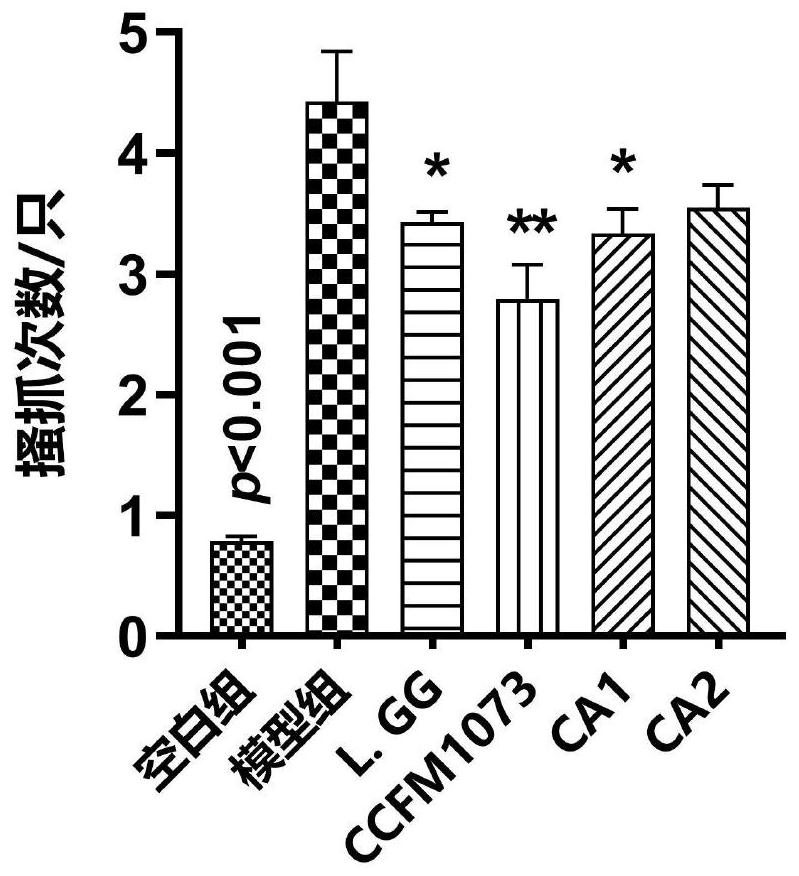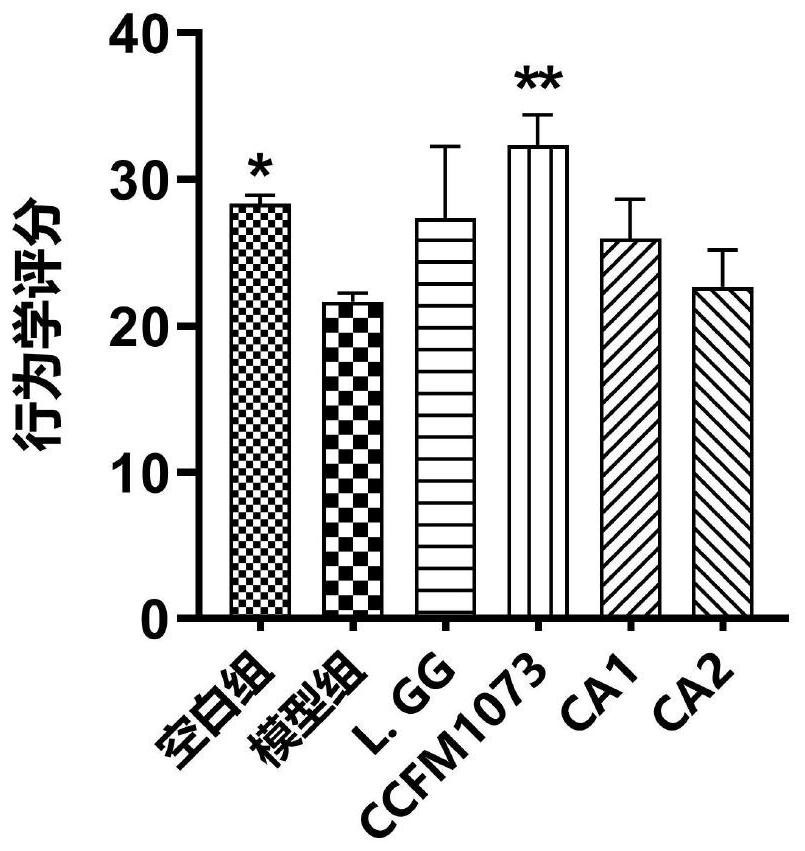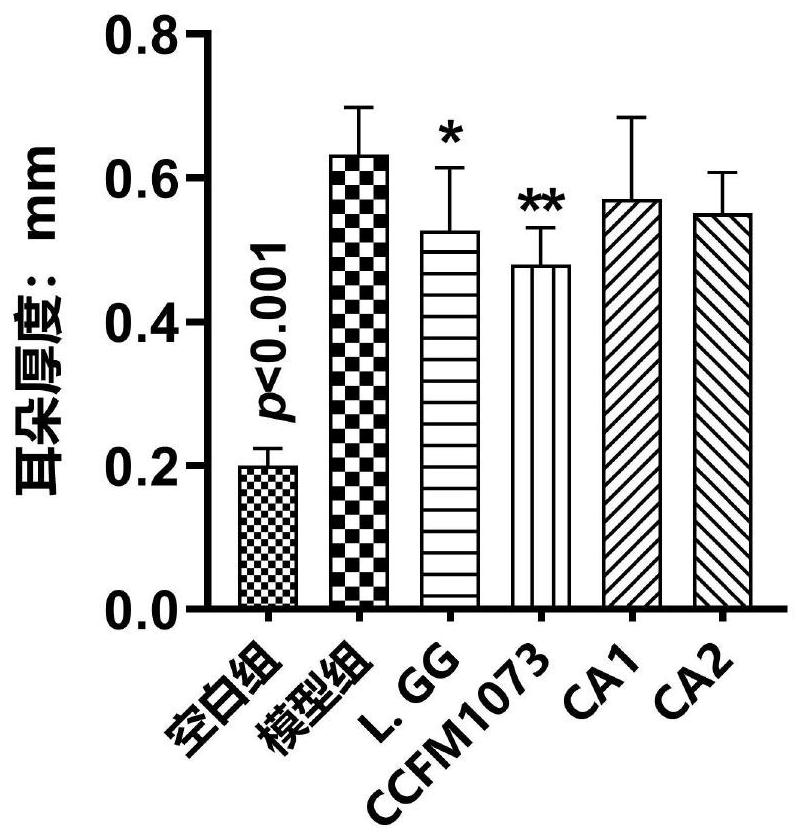A product for preventing and/or treating atopic dermatitis
A technology for atopic dermatitis and products, applied in the field of microorganisms, can solve problems such as adverse reactions, poor tolerance of patients, and life troubles of patients, and achieve the effect of reducing the number of scratches, improving skin pathological symptoms, and improving behavioral characteristics
- Summary
- Abstract
- Description
- Claims
- Application Information
AI Technical Summary
Problems solved by technology
Method used
Image
Examples
Embodiment 1
[0055] Example 1: Effects of different Lactobacillus casei on scratching times in mice with atopic dermatitis
[0056] Thirty-six 6-week-old SPF (specific pathogen free) C57BL / 6 female mice were randomly divided into 6 groups with 6 mice in each group. The 6 groups were: blank group, model group, positive reference group and three groups of cheese milk Lactobacillus experimental group, among which, the positive reference group is L.GG group by gavage of Lactobacillus rhamnosus GG, the three groups of L. The CA1 group and the CA2 group that received Lactobacillus casei 2 by gavage. All mice were housed within an SPF barrier with free access to food and water.
[0057] The experiment consisted of four weeks: the first week was the adaptation period of the mice; the second week started the gavage until the end of the experiment, the positive control group and the three Lactobacillus casei experimental groups were respectively gavaged with Lactobacillus rhamnosus GG, Lactobacillu...
Embodiment 2
[0060] Example 2: Effects of different Lactobacillus casei on behavioral indexes of mice with atopic dermatitis
[0061] Thirty-six 6-week-old SPF (specific pathogen free) C57BL / 6 female mice were randomly divided into 6 groups with 6 mice in each group. The 6 groups were: blank group, model group, positive reference group and three groups of cheese milk Lactobacillus experimental group, among which, the positive reference group is L.GG group by gavage of Lactobacillus rhamnosus GG, the three groups of L. The CA1 group and the CA2 group that received Lactobacillus casei 2 by gavage. All mice were housed within an SPF barrier with free access to food and water.
[0062] The experiment consisted of four weeks: the first week was the adaptation period of the mice; the second week started the gavage until the end of the experiment, the positive control group and the three Lactobacillus casei experimental groups were respectively gavaged with Lactobacillus rhamnosus GG, Lactobacil...
Embodiment 3
[0065] Example 3: Effects of different Lactobacillus casei on ear thickness of mice with atopic dermatitis
[0066] Thirty-six 6-week-old SPF (specific pathogen free) C57BL / 6 female mice were randomly divided into 6 groups with 6 mice in each group. The 6 groups were: blank group, model group, positive reference group and three groups of cheese milk Lactobacillus experimental group, among which, the positive reference group is L.GG group by gavage of Lactobacillus rhamnosus GG, the three groups of L. The CA1 group and the CA2 group that received Lactobacillus casei 2 by gavage. All mice were housed within an SPF barrier with free access to food and water.
[0067] The experiment consisted of four weeks: the first week was the adaptation period of the mice; the second week started the gavage until the end of the experiment, the positive control group and the three Lactobacillus casei experimental groups were respectively gavaged with Lactobacillus rhamnosus GG, Lactobacillus c...
PUM
 Login to View More
Login to View More Abstract
Description
Claims
Application Information
 Login to View More
Login to View More - R&D
- Intellectual Property
- Life Sciences
- Materials
- Tech Scout
- Unparalleled Data Quality
- Higher Quality Content
- 60% Fewer Hallucinations
Browse by: Latest US Patents, China's latest patents, Technical Efficacy Thesaurus, Application Domain, Technology Topic, Popular Technical Reports.
© 2025 PatSnap. All rights reserved.Legal|Privacy policy|Modern Slavery Act Transparency Statement|Sitemap|About US| Contact US: help@patsnap.com



